
 |
Una Cunningham
University of Canterbury, New Zealand
This study examines what happens when online and campus students participate in real time in the same campus classroom. Before this study, postgraduate students studying online in a course intended primarily as professional development for language educators were taking the course through reading the course literature including assigned articles, writing reflective texts in the asynchronous forum and doing the course assignments. They had a very different experience than the campus students who met weekly for discussion of the reading. Some online students were not active enough in the course, and showed low levels of engagement. The online students were invited to participate in scheduled campus classes via Skype on iPads. After some hesitation, four of the six online students took up this real-time participation option. Initial difficulties with the technology were addressed after seeking input from campus and online students. A series of adjustments were made and evaluated, including a move to a model in which three online students in different locations participated in a single Skype group video call on a laptop in the campus classroom rather than on multiple individual Skype calls on iPads. After the course, the online and campus students were asked to evaluate the experience of having physical and virtual participants sharing a physical space and to relate this experience to the asynchronous channels previously available to the participants. The comments of both groups of participants were interpreted in the light of previous work on social presence and of activity theory. It appears that student beliefs and student expectations lead to hidden challenges associated with mixing these groups of students, and the study concludes that unless teaching assistance is available, it is not easy to afford online students the same right to speak as campus students.
Keywords: Distance; campus; blended; flexible; synchronous; Skype; VOIP; activity theory; othering; social presence
Those who watched the UK TV-series, Doctor Who, in the 1970s (or who have seen some of the countless re-runs) may remember the Brain of Morbius, the title role in a set of episodes of the series. The evil Time Lord, Morbius, had been reduced to life as a brain in a plastic bowl. He could not move unaided, though he could speak and was actually quite demanding of those around him. The plight of Morbius came to mind in the particular approach to blended synchronous learning adopted in the postgraduate course that is the focus of this study. Campus students sitting around a seminar table in class were joined by a handful of online students, each occupying an iPad, placed so they could see their campus and online classmates and be seen by them. The online participants, like Morbius, were fairly helpless, needing assistance from another student or the teacher to move to another table to take part in small-group discussion or to turn to face the talker or the screen at the front of the room. Their ability to hear and be heard was at the discretion of the physically present. These were postgraduate students, studying online on a course intended primarily as professional development for language educators. These students are referred to here as online, rather than distance students as they are often not geographically removed at all, but prefer to study online because of the flexibility of online study in this particular postgraduate course, using various permutations of synchronous and asynchronous communication as they wish.
The problem under investigation is the reluctance of some online students to participate actively in the course asynchronous discussion forum on the university’s Moodle-based learning platform. This apparent lack of engagement in the course meant that these students were not interacting. There was little rapport between the teacher and the online students and none at all between the students. Many online educators have considered ways to increase student interaction in online courses (Murphy & Rodriguez, 2012). A study by Power and Vaughan (2010) claimed that synchronous online interaction between students will “reduce learner isolation through real-time dialog and co-construction team activities (p. 23)”. They further suggest that students will get more out of a course if there is real-time contact between students. Student isolation and failure to engage with the course materials and activities may mean that the flexibility offered by online studies is sometimes countered by a lower completion rate (Power & Vaughan, 2010). It is often difficult to engage remote learners, who may have chosen online study because of work and family obligations (James, Krause & Jennings, 2010), meaning they have little time for their studies.
Previous experience on this course was that some online students who interacted with their fellow students only through the asynchronous forum were disengaged and reluctant to communicate more than minimally. Studies of social interaction using asynchronous modes of communication suggest that a sense of shared purpose is essential to successful online interaction (Westberry & Franken 2013). However, students who only communicate asynchronously with their teachers and fellow students may miss out on “collaborative learning activities, which are a cornerstone of contemporary social constructivist pedagogical approaches” (Bower, Kenney, Dalgarno, Lee & Kennedy 2013, p. 92). Bower et al. also point out that because of this lack of interaction, and reliance on asynchronous written communication, online studies are sometimes, for example in Australia, not seen as equivalent to face-to-face learning.
Clearly the conditions of technology-mediated communication as well as the individual situations of students who choose to study online complicate the need for well designed courses that offer flexible options for interaction between students and with the teacher. For those students who attend real-time classes, whether on campus or online, a social context is provided. For students who cannot join the real-time classes, other options need to be offered.
The aim of this study was to investigate possible ways to reduce the isolation of online students and to extend to them something of the social and educational advantages experienced by campus students who are able to interact with the teacher and with each other in real time. The online students were offered the opportunity to virtually sit in on campus classes in real time. The learning experiences of both online and campus students were assessed, and the intervention was refined accordingly and then reassessed.
To facilitate interaction between participants in the course at the focus of this study, the six online students were invited to participate in real time in a scheduled campus class with the twelve campus students via Skype on iPads in a blended-synchronous model. The purpose of this invitation was to allow engagement in what White, Ramirez, Smith and Plonowski (2010, p. 35) termed “a similar manner to on-campus students”. This was in order to create the basis for a social constructivist learning environment. After initial hesitation, due to time constraints, work commitments or the high cost of broadband connectivity, four online students engaged in the online synchronous participation option. The means of communicating synchronously with the online students during the campus class was introduced, evaluated and refined in an iterative approach.
The experiences of the campus and online students were elicited twice, firstly informally in class and by inviting e-mail comments, and secondly by inviting them to participate in an anonymous written evaluation of the teaching set-up via Google Forms. Observations, spontaneous comments and elicited responses were considered with respect to the community of inquiry constituted by the course, in particular as regards the social presence of the online participants from the perspective of the campus participants. In addition, the course was analysed as partly overlapping activity systems following aspects of activity theory as characterized by Nardi (1996).
In the first attempt to solve the problem of the disengaged online learners, four iPads were brought into the classroom (each with a different Skype account so they could host simultaneous individual Skype video calls), one for each of the four online students who had expressed willingness to participate in the real-time class with some twelve campus students. The iPads were placed around the table, between campus students such that nearby campus students were asked to turn an iPad as required. This set up was used for the first half of the course, six seminars. During the seminars, problems (such as dropped calls, or online students sitting in noisy environments) and effects arising (such as students experiencing difficulty hearing the online students when the classroom became noisy during small group discussion) were noted. In the sixth seminar of the course, all the participants were asked openly for their thoughts on a) how they thought the course was going in general and b) their thoughts and suggestions about the blended synchronous model with the iPads, and they were invited to mail the lecturer with any further points that they were not comfortable sharing openly.
Observations and spontaneous comments suggested that the model in which online students were each represented in the physical space of the classroom as a face on a tablet device led to them being seen as real people by the campus students. Campus students looked at the faces on the iPads as though they were classmates and would glance in their direction when referring to a point made by a online participant. This can be termed perceived social presence (Kim 2011; Hostetter & Busch 2013). Social presence has been defined as the “degree to which a person is perceived as a ‘real person’ in mediated communication” (Gunwardena & Zittle, 1997, p. 9).
The discourse in the focus classroom evolved so that campus students began to refer to the online participants in a way reminiscent of the way disabled campus students might be referred to, that is, when a campus student was asked to help a named online student to turn to see the board, rather than being asked to turn the tablet. However, it also became apparent that the two groups of students, the virtual and the physical, were having partially different classroom experiences (c.f. Westberry & Franken 2013). Some campus students were reluctant to take responsibility for facilitating for a online student by taking them along to another table for a small group discussion or turning the iPad to face the speaker in whole class teaching or discussion.
One of the constraints of Skype on an iPad using the built-in speakers was that it was not full duplex, meaning that the sound was not transmitted simultaneously in both directions, so that in noisy environments the sound would not be received well. In the classroom, this meant that while whole class teaching and discussion where one campus or online participant at a time was talking went well, as soon as small group or pair discussions started, the online participants had difficulty hearing, and the ambient noise meant that the campus students had difficulty hearing the online students. Campus and online students raised their voices to attempt to be heard, which made things more difficult. The volume of the iPads was raised to max, which meant that the online students’ voices were perceived as penetrating and somewhat abrasive. These sound problems led to some irritation in both groups.
The positive experiences of this set-up, with the online students present on iPads, were that they were able to ask questions during class, that they could join in whole class and small group discussion and that they got to know the campus students and each other a little. The negative experiences included the sound problems with the students’ voice quality and their difficulty hearing what was going on when the room became noisy, that not all online students were able to or chose to join the campus class, and that the forum activity was much less than before, as the most active students were the ones who had accepted the invitation to participate in real time.
In an attempt to solve the problems experienced in the first half of the course, namely a reluctance by some campus students to be responsible for facilitating for their remote peers, and the specific sound problems caused by the set up, a new set-up was implemented. The first adjustment was to set-up a Skype account that allowed multiple participants on video calls. This meant that the online students participated in a group video call on a laptop rather than on multiple individual Skype calls on iPads. The second adjustment was that the lecturer took on the responsibility of facilitation for the online students, turning the computer so the webcam captured the person speaking at any time. The third adjustment was in the way small group discussion was treated. The participating online students (by now only three or sometimes two) were treated as a single group for small group discussions, and the computer microphone and speakers were disabled during the group discussions, meaning that the online students could neither hear what was going on in the classroom, or be heard by anyone in the classroom during the small group breakouts.
The remainder of the course proceeded in this way. The new order of the reduced physical presence of the two or three online students, now on a single laptop rather than each occupying an iPad worked with fewer sound problems. On one occasion, one of the online students had children in the room and did not know how to disable the computer microphone. This meant that the computer speakers had to be temporarily disabled, leaving the other online students unable to participate orally, although they could still use the text chat function. When one of the students lost the connection with the call, the lesson paused while the teacher reconnected the call.
A teaching assistant who could deal with technical hiccups would have made things a lot easier for the teacher and caused fewer delays for the other students. This is in line with the findings of White et al. (2010), who also point out that a second teacher in the room would make using technology a lot easier, although in their study they did not elicit feedback from campus students. Bower et al. (2013) reported case studies where teachers claimed that having a teaching assistant was highly advantageous in helping to deal with the increased cognitive load required to manage blended synchronous learning classes. They also identified capturing and managing audio discussions as a major challenge of the blended synchronous teaching (p. 100). In fact, most of the case studies reported by Bower et al. did not allow online students access to the microphone, which is a clear disempowering of these students, but a concession to the constraints of blended synchronous learning, as managed by a single teacher.
Towards the end of the course, the online and campus students were asked to anonymously evaluate the experience of having physical and virtual participants sharing a physical space and to relate this experience to the asynchronous channels previously available to the participants (cf. Garrison & Cleveland-Innes, 2005). This evaluation was separate from the regular student course evaluation, and focused entirely on the mode of teaching. Using Google forms, students were asked to respond to the following prompts:
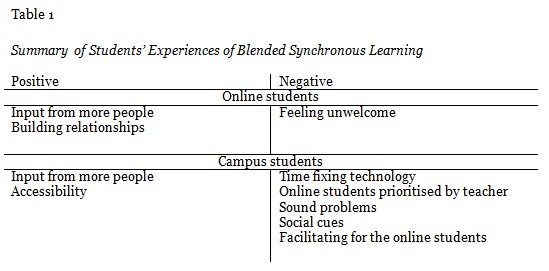
Eleven students chose to respond, eight campus students, two online students, and one student who reported having taken part in both campus and online modes. A number of students did this, both online students who found themselves on campus at class time, and campus students who had to stay at home for personal reasons. The responses were carefully considered and a number of themes emerged. These are presented in Table 1. See the Appendix for full survey responses.
While the online students appreciated being part of the class and hearing the teacher and taking part in discussions, they did not quite feel welcomed by the campus students. Some of the comments from campus students suggest that this feeling was well-grounded, as there seemed to be some resentment of the time and effort taken to satisfy the technical needs of online students, and a lack of understanding of the affordances of their mode of participation regarding their perception of social cues.
The students in both groups were also asked to comment on the move from using several iPads with one online student per iPad to having a single Skype conversation on the laptop. Their responses are summarised in Table 2, again with full responses in the Appendix.

The isolation of the online students for small-group discussion was seen as a disadvantage by the online students but as a relief by most campus students who mentioned it. Both groups (online and campus students) reported seeing the other group as quite separate from themselves. This is similar to the othering described by Palfreyman (2005), with both groups talking about us and them, with little realisation that they were in fact very similar to each other; the online students expressed feeling excluded from the campus students’ social community. This was interesting since there was actually some movement of students from campus to online and viceversa. There also seemed to be a monitoring of teacher time and attention dedicated to the other group on the part of some participants in both groups.
The tensions between online and campus students in this study appear to be partly due to the perceived reality of the online students, and their status as full members of the class community. The aim of the study was to afford the online students greater access to the class community with a view to enhancing their socio-constructivist learning experience. The idea that learners as a community of inquiry can together discover more than each individual alone is capable of was developed by a series of scholars including Peirce, Wells, Lipman and Sexias (Pardales & Girod, 2006). Lipman (2003 pp. 95-100) lists some features of communities of inquiry including inclusiveness, participation, shared cognition, face-to-face relationships and feelings of social solidarity. Some of these features are noteably lacking in the blended group at the focus of this study. Of face-to-face relationships Lipman writes “these relationships may not be essential to communities of inquiry, but they can be very advantageous. Faces are repositories of complex textures of meaning that we constantly try to read and interpret” (p. 95) The computer-mediated communication of the blended synchronous classroom, especially when several faces appear as small images on a single screen, is not conducive to this kind of interpretation of meaning.
Garrison and Anderson (2003) reported their application of the community of inquiry model to online learning, where the components of cognitive presence, social presence and teaching presence interacted. They had earlier defined social presence as “the ability of participants in a community of inquiry to project themselves socially and emotionally, as real people (i.e., their full personality), through the medium of communication being used”(Garrison, Anderson & Archer 1999, p. 94). Social presence is clearly highly relevant to the experience of the participants in the course described in this study. If the online students are perceived as real people by the campus students, even if they are not able to move independently and have limited vision and hearing, they are worthy of all the consideration due to disabled classmates. Garrison offered a new, farther-reaching, definition of social presence as “the ability of participants to identify with the group or course of study, communicate purposefully in a trusting environment, and develop personal and affective relationships progressively by way of projecting their individual personalities” (2011, p. 34). The campus students achieved this in the course studied in this paper; the online students less so, though considerably more so than when they only interacted through asynchronous text-based forums.
However, Gunawardena and Zittle (1997) found that social presence alone may be a very strong predictor of satisfaction in online learning, and they cite earlier work by Short, Williams and Christie (1976) ranking text-based computer-mediated communication (devoid of nonverbal codes that are generally rich in relational information), audio only communication and video (or television as it was in the 1976 study) in increasing order of social presence. Gunawardena and Zittle (1997, p. 9) conclude that “the capacity of the medium to transmit information about facial expression, direction of gaze, posture, dress, and nonverbal cues all contribute to the degree of social presence of a communications medium”. Increased connectivity and technological development have led to richer media being available for educational communications, and the affordances of the communication tools now used facilitate considerable social presence.
The role of technological development in the tools available for online education is also mirrored by pedagogical development, as noted by Garrison (2012), responding to a article by Annand (2011) which questioned the importance of social presence. Garrison pointed to a generational shift from distance education, which was, he claimed, concerned with information transmission, to online learning in a collaborative constructivist approach with “collaborative discourse in purposeful communities of inquiry” (2012, p. 251). The course discussed here is designed so that the co-construction of knowledge by collaborative discourse is at its centre. Without interaction, the learning in a course of this kind will be essentially different and fail to be enriched by the collective professional experiences of the group. Any online students who do not engage with their classmates will miss out on large parts of the intended learning. The interaction needed for this kind of learning requires students to experience their own and their peers’ social presence in the community.
Other components of online presence may also have a bearing on the perception of students. Cleveland-Innes and Campbell (2012, p. 283) considered emotional presence to exist alongside social presence, and define it as “the outward expression of emotion, affect and feeling by individuals and among individuals in a community of inquiry as they relate to and interact with the learning technology, course content, students and the instructor”. The responses elicited from the participants in the course in this study, where online students sometimes felt that their comments were not picked up by campus students, suggest that the need for recognition and appreciation from the teacher and fellow students experienced by some students is a hinder to their interaction, and must be addressed.
Similarly, the learning experiences of the students will vary according to the way they engage with the material and the other participants. Akyol and Garrison (2011) discussed the role of cognitive presence, and cited early work on deep and surface learning approaches by Marton and Säljö (1976) as relevant to the context of online learning. Akyol and Garrison reported different levels of social, cognitive and teaching presences in online and blended courses and concluded that “cognitive presence in a community of inquiry is strongly associated with high levels of perceived learning” (2011). They noted that students in a blended course had higher perceptions of learning, satisfaction, cognitive presence, teaching presence and social presence than those in an online course. This was attributed to the blended students having weekly discussions in face-to-face meetings. The affordances of the tools used in the current study were such that all students, campus and online, were able to participate in intergroup and intragroup discussions.
Activity theory as developed by Engeström from Leont’ev’s earlier work, and described by Nardi (1996) offers a set of conceptual tools for describing a technology-mediated activity. Nardi noted that “technology use is not a mechanical input-output relation between a person and a machine; a much richer depiction of the user’s situation is needed for design and evaluation” (p. 4). Nardi described activity theory as “...a powerful and clarifying descriptive tool rather than a strongly predictive theory” (p. 6) and this is how it has been used here, to clarify the tensions between the different groups of students. Activity theory allows activities to be described as systems with specific roles for the subject and object, considering rules, instruments or mediating artefacts, division of labour and community.
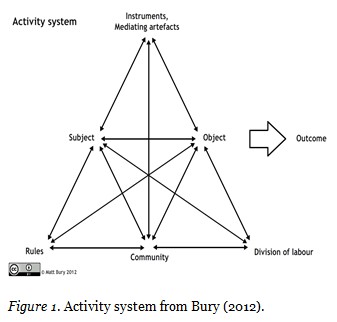
Previous studies have applied activity theory to higher education settings (Barab, Evans & Baek 2004; Brine & Franken 2006) and have found the model helpful in describing the dynamics of classes, looking at aspects of the seminars as activities with subjects and objects and rules for each group. It appears that student beliefs and student expectations lead to hidden benefits and hidden challenges associated with mixing these groups of students (Westberry & Franken 2013).
Recent work applying activity theory to technology-mediated higher education (e.g., Murphy & Rodríguez-Manzanares, 2014) suggests that this approach can give insight into the tensions that arise when activity systems overlap. Applying the lens of activity theory to the study at hand, the comments of both groups of course participants were interpreted to inform the description of each group’s activity system. Consider Figure 1 and Table 3 where the activity systems of online students and campus students are explored separately.
From this analysis it can be seen that campus and online students are working towards the same outcome, discussion and learning in order to complete the course successfully, but they are not operating in the same community or according to the same rules.
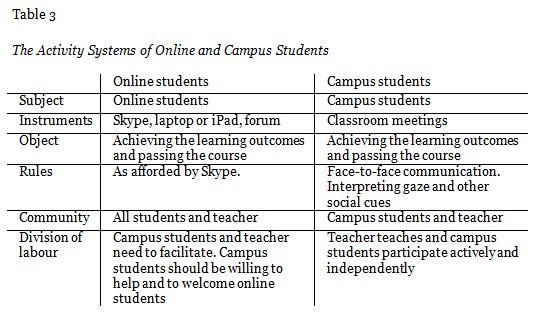
The tension arises because the online students believe they are part of the campus students’ community, and the campus students expect them to behave like physically present campus students and conform to the same norms, even though their instruments are different and have different affordances. Both groups expressed resentment of the other group; this arises from the two groups not realizing the differences between their situations with each expecting the other group to behave more like themselves. Clearly, things would have progressed more harmoniously if all the students were aware of the needs of both groups, and if clear rules for classroom discourse had been co-constructed with the students at the beginning of the course.
One of the fundamental differences between campus and online students is that campus students occupy a physical space in the classroom. They are each assigned a seat and a few decimeters of table space. They are represented in the classroom by their bodies in full size, with all that means in terms of being able to use facial expression, gesture and body language to add to anything they might actually say in class, either to the class as a whole, to the teacher or to the person sitting next to them. Online students, on the other hand, do not have their physical body in the classroom. Like Morbius, they are disembodied. They do not have access to these same linguistic, paralinguistic and extralinguistic means of expression. Depending on the way the course is set up, on courses that also have a campus occurance, online students may be able to view recordings of campus classes or to view them in real time (like a fly on the wall). In the latter case they may be able to interact with the teacher, the other online students and/or with the campus students. This interaction is often accomplished using text chat rather than voice communication.
The blended synchronous set-up including online students in the classroom via Skype on individual tablets described in this study was an attempt to address the limitations of this kind of fly-on-the-wall experience. However, even in the most empowering set-up described in this study, the online students could be silenced or rendered deaf or blind at the flick of a switch, and they could not move themselves independently to turn to see who was speaking or to the board.
The justification of this study was to move some way to compensating the online students for these limitations. By allowing each online student to participate in the class via an individual Skype connection on a tablet, they were each represented in the physical space of the campus classroom by the moving image of their head on the screen of the tablet. While they were still not physically present in the classroom, they were represented in physical space, embodied in the tablet, in a way that was lost when the move was made to having several online students communicating via a single Skype channel on a laptop. While their moving heads could still be seen in the second set up, they had lost their position around the table, each as an individual student, taking a place among the other students.
If online learners can be said to be disembodied, giving them a physical presence increases their social presence as perceived by campus students. Synchronicity of interactions between online and campus students can increase the sense of community and perceived by online students.
An important insight gained from this study was that, given their reduced ability to pick up on the social cues of the campus students (raised hands, gaze, impatient fidgeting, etc.), it was difficult to afford online students in a blended synchronous classroom free access to speaking rights. Instead, they could be asked to indicate when they want to say something (in text, or by raising their hands, literally or otherwise), or even be limited to written participation if there are more than a few of them.
Moving on from the course described in this study, the decision was made in a subsequent blended synchronous course to use Adobe Connect for live streaming from the campus class. Online students could participate in real time, and could, if they chose, activate their webcams and microphones. Preliminary findings from this course suggest that online students who had never experienced having a voice in the campus classroom did not miss it, and threw themselves enthusiastically into real-time text chat communication with each other, the teacher and the campus students, actually being reluctant to switch on a microphone when asked to do so for a discussion, and choosing not to activate their webcams. There was also an increased degree of movement from campus to synchronous online participation in this class, as students choose to stay at home and sit in on the campus class from the comfort of home. Also, as the Adobe Connect sessions were recorded, and the recordings were made available to all students, some students preferred to view after the event, mailing any questions that arose as they viewed the classes to the teacher.
This drift of some students from campus to the digitally mediated synchronous classes led to a decision by the teacher to move new courses away from campus altogether, being set up as online only, combining the advantages of non-transient pre-recorded lectures, live webinars and online tutorials (Q&A sessions) which are recorded for later (re)viewing and asynchronous forums. This kind of course is quite different than the blended synchronous course that is described in this study, but the flexibility it offers is greatly enhanced. The physical classroom experience is sacrificed, but the online experience will be better, and there will no longer be a distinction between campus and online students, though the distinction between the students who participate in live webinars and tutorials and those who view only recorded material may become more prominent. More research is needed to examine the student experience in this kind of course, and to see if students miss the classroom.
Akyol, Z., & Garrison, D. R. (2011). Understanding cognitive presence in an online and blended community of inquiry: Assessing outcomes and processes for deep approaches to learning. British Journal of Educational Technology, 42(2), 233 – 250.
Annand, D. (2011). Social presence within the community of inquiry framework. International Review of Research in Open & Distance Learning, 12(5), 38-54. Retrieved from http://www.irrodl.org/index.php/irrodl/article/view/924/1855
Barab, S. A., Evans, M. A., & Baek, E. O. (2004). Activity theory as a lens for characterizing the participatory unit. In D. H. Jonassen (Ed.), Handbook of research on educational communications and technology (pp. 199-214). Mahwah: Lawrence Erlbaum Associates.
Bower, M., Kenney, J., Dalgarno, B., Lee, M.J.W. & Kennedy, G.E. (2013). Blended synchronous learning: Patterns and principles for simultaneously engaging co-located and distributed learners. In H. Carter, M. Gosper and J. Hedberg (Eds.), Proceedings of the 30th ASCILITE Conference. Sydney, Australia, 1st-4th December 2013. Retrieved from: http://www.ascilite.org.au/conferences/sydney13/program/handbookproceedings.php
Brine, J. & Franken, M. (2006). Students’ perceptions of a selected aspect of a computer mediated academic writing program: An activity theory analysis. Australasian Journal of Educational Technology, 22(1) 21–38.
Bury, M. (2012) Activity system. Accessed at http://commons.wikimedia.org/wiki/File:Activity_system.png.
Cleveland-Innes, M., & Campbell, P. (2012). Emotional presence, learning, and the online learning environment. International Review of Research in Open & Distance Learning, 13 (4), 269-292.
Garrison, D.R. (2012) Social presence within the community of inquiry framework. International Review of Research in Open & Distance Learning 13 (1), 250-253-
Garrison, D. R., & Cleveland-Innes, M. (2005). Facilitating cognitive presence in online learning: Interaction is not enough. The American Journal of Distance Education, 19 (3), 133–148.
Garrison, D.R. (2011). E-learning in the 21st century: A framework for research and practice (2nd ed). New York: Routledge.
Garrison, D.R., Anderson, T. & Archer, W. (1999). Critical inquiry in a text-based environment: Computer conferencing in higher education. The Internet and Higher Education, 2 (2-3), 87-105.
Garrison, D. R., & Cleveland-Innes, M. (2005). Facilitating cognitive presence in online learning: Interaction is not enough. The American Journal of Distance Education, 19 (3), 133–148.
Gunawardena, C.N., & Zittle, F.J. (1997) Social presence as a predictor of satisfaction with a computer-mediated conferencing environment. American Journal of Distance Education, 11 (3), 8-26.
Hostetter, C. & Busch, M. (2013). Community matters: Social presence and learning outcomes. Journal of the Scholarship of Teaching and Learning 13 (1), 77 – 86.
James, R., Krause, K. & Jennings, C. (2010). The first year experience in Australian universities: Findings from 1994 to 2009. Melbourne, Australia: The University of Melbourne, Centre for the Study of Higher Education. Retrieved from http://www.cshe.unimelb.edu.au/research/FYE_Report_1994_to_2009.pdf
Kim, J. (2011), Developing an instrument to measure social presence in distance higher education. British Journal of Educational Technology 42, 763–777.
Lave, J., & Wenger, E. (1991). Situated learning: Legitimate peripheral participation. Cambridge: Cambridge University Press.
Lipman, M. (2003). Thinking in education. (2nd ed.). Cambridge: Cambridge University Press.
Murphy, E. & Rodríguez-Manzanares, M.A. (2012). Rapport in distance education. International Review of Research in Open & Distance Learning 13 (1), 167-190.
Murphy, E. & Rodríguez-Manzanares, M.A. (2014). Activity theory perspectives on technology in higher education. Hershey, PA: IGI Global.
Nardi, B. A. (1996). Activity theory and human computer interaction. In B. A. Nardi (Ed.), Context and consciousness: Activity theory and human-computer interaction (pp. 1-8). Cambridge, Massachusetts: The MIT Press.
Palfreyman, D. (2005). Othering in an English language program. TESOL Quarterly 39 (2), 211-233.
Pardales, M. J., & Girod, M. (2006). Community of inquiry: Its past and present future. Educational Philosophy and Theory, 38(3), 299-309. doi:10.1111/j.1469-5812.2006.00196.x
Power, T.M. & Vaughan, N. (2010). Redesigning online learning for international graduate seminar delivery. The Journal of Distance Education, 24 (2), 19-38.
Westberry, N. & Franken, M. (2013). Co-construction of knowledge in tertiary online settings: an ecology of resources perspective. Instructional Science 41 (1), pp 147-164.
White, C.P., Ramirez, R., Smith, J.G. & Plonowski, L. (2010). Simultaneous delivery of a face-to-face course to on-campus and remote off-campus students. TechTrends, I (4), 34-40.
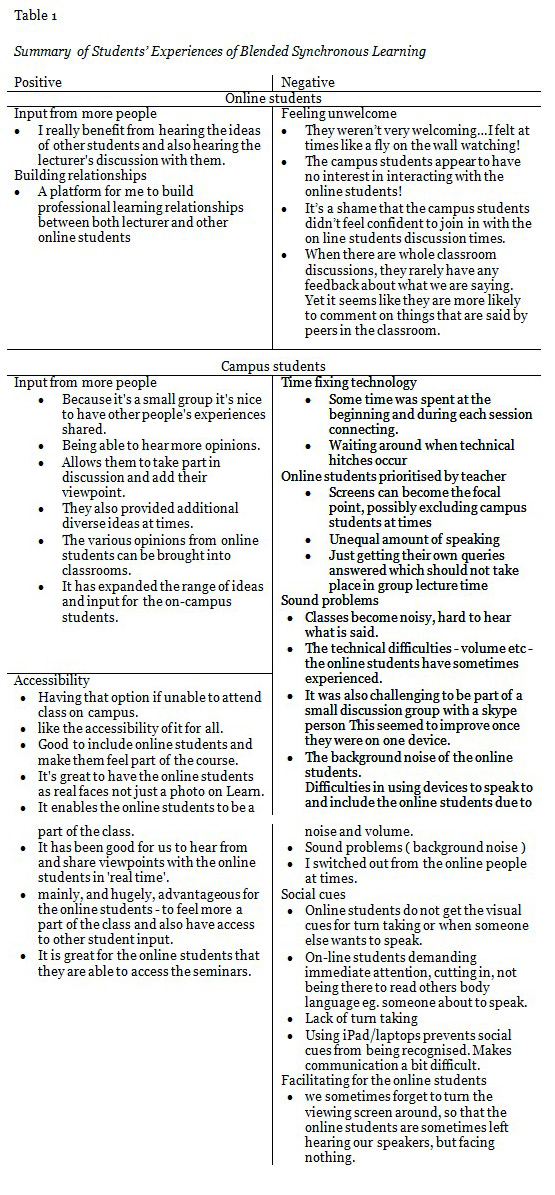
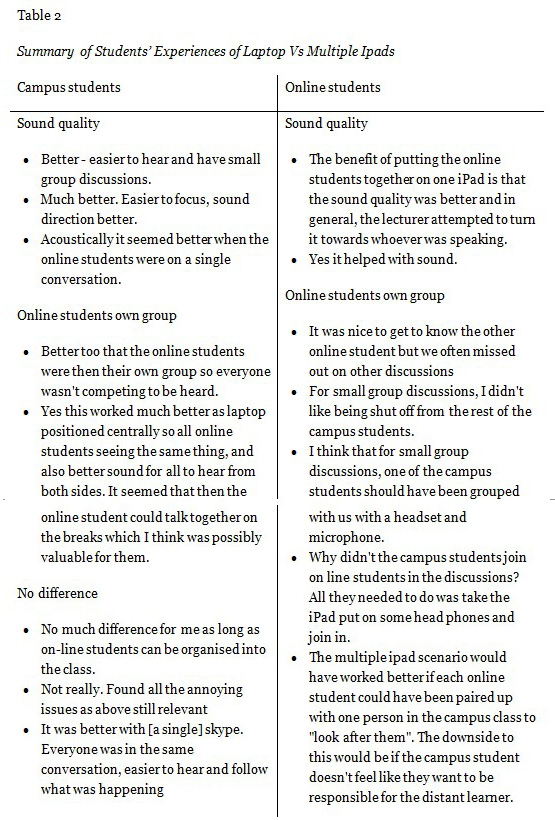
© Cunningham